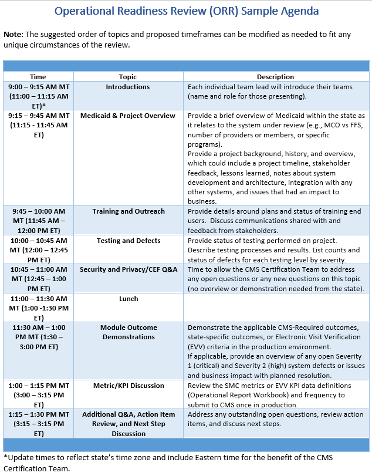Development
At the beginning of the Design, Development, and Implementation (DDI) phase, the state should develop a Master Test Plan, in consultation with the Testing Guidance Framework. The Master Test Plan describes in detail how the testing is being planned and how it will be managed across different test levels. It gives a bird’s eye view of the key decisions taken, the strategies to be implemented, and the testing effort involved in the project.
If a state is using agile methodology or is taking a phased approach to implementation, the state and its CMS State Officer will decide the appropriate point at which to conduct the ORR and CR. The state must map the phases to the applicable CMS-required and state-specific outcomes to help the CMS Certification Team determine when to hold the ORR and CR.
To provide regular project updates, monthly project status should be submitted to their CMS State Officer. The project status reports should be loaded to the appropriate CMS Box certification folder starting at the beginning of the project and continuing until the CR is completed or until the CMS SO agrees it is no longer needed.
Operational Readiness Review (ORR)
The state must undergo an ORR with its CMS State Officer prior to releasing its system/module into production. CMS encourages states to include all appropriate programs, business operations, and IT subject matter experts in the ORR.
The state will be able to schedule its review no more than three months in advance of the target date. For example, if the state intends to hold an ORR in March, then they can submit their request for the review as early as January.
Prior to requesting to schedule an Operational Readiness Review (ORR), the state must provide the following information:
- Anticipated Go-live date
- The state should also provide detailed go/no-go exit criteria and the decision date.
- User Acceptance Testing (UAT) completion date
- The state must provide a timeline for when UAT for go-live functionality will be complete. Additional guidelines can be found in MES Testing Guidance Framework.
- Operational Reporting / Metrics
- Latest Intake Form
- This can be a draft but will need to be finalized and loaded to the applicable certification Box folder two weeks prior to the actual review. This allows the Certification Team to review and ensure that all the CMS-required outcomes and Conditions for Enhanced Funding have been appropriately captured and identify opportunities for technical assistance.
- The following files or a projected timeline for completion:
- The independent, third-party security and privacy controls assessment report (SAR) and penetration test results conducted within the last two years, per 45 C.F.R. § 95.621(f)(3), from the requested ORR date.
- If this is for an Eligibility & Enrollment (E&E) review, the state must provide the most recent Authority to Connect (ATC) to the CMS Hub approval letter.
- Plan of Action & Milestones (POA&M) documenting the most recent status of vulnerabilities regardless of risk level (from SAR, penetration tests, vulnerability scans, disaster recovery test results).
- All critical vulnerabilities should be resolved prior to scheduling a review date. However, states can request a date with unresolved critical items if a mitigation/remediation plan is submitted using the recommended risk acceptance template, which can be found in Attachment D of the CMS Information Security POA&M Procedure document.
- The independent, third-party security and privacy controls assessment report (SAR) and penetration test results conducted within the last two years, per 45 C.F.R. § 95.621(f)(3), from the requested ORR date.
- Latest Intake Form
- Link to CMS Box location
- Work with your CMS State Officer, who will set up a file structure in CMS Box and provide this link.
Note that meeting the above entry criteria for ORR only clears the way for scheduling the ORR. Two weeks prior to the ORR, the state must provide the most up-to-date documents in the applicable certification Box folders for evaluation by the CMS Certification Team.
For the ORR, the following steps are completed:
- The state finalizes the state columns of the Intake Form.
- The state must use the exact filename(s) loaded in CMS Box when populating the Intake Form evidence columns.
- Preferably, earlier but no later than two weeks before the ORR, the state uploads all evidence, required artifacts, the Intake Form, Operational Report Workbook, the ORR agenda, and the presentation the state will use for the ORR in the CMS Box certification folder.
- No files uploaded to CMS Box should be redacted, including but not limited to security risk assessments, penetration tests, screen prints, or reports that include PHI/PII.
- The state notifies the CMS State Officer when they have completed loading all documentation (no later than 2 weeks prior to the review date).
- The CMS Certification Team will then begin a review of the evidence and required artifacts.
- Approximately one week prior to the review, an Information Request Listing (IRL) will be sent to the state by the CMS Certification Team. This includes questions and feedback on the files uploaded to the CMS Box. Although providing written responses to these questions before the review is encouraged, it is not mandatory. The state should be prepared to address all outstanding questions from the IRL during the ORR or CR discussions and demonstrations.
- The ORR meeting is held, and action items are documented, reviewed, and agreed to.
- The state should try to respond to all action items as soon as possible, preferably within 24 hours.
- A Tear-out will be created by the CMS Certification Team including observations, recommendations, and action items. The Tear-out will be sent to the state along with an updated Intake Form (with CMS columns filled out) approximately one week after the ORR meeting.
- The Tear-out recommendations should be reviewed, and action should be taken as necessary (not required), as the state’s response will need to be reviewed during the CR. The state should continue working with its CMS State Officer to address all observations as the project goes into production and in preparation for the CR.

Review Preparation
- States are highly encouraged to utilize the sample agenda provided by the CMS Certification Team, see the example below.

Download the ORR Sample Agenda
Resources
- SMC Guidance
- Code of Federal Regulations
- Templates
- Metrics and Ongoing Reporting (includes FAQs under the Resources section)
- CEF Example Evidence, Tips, and Best Practices
- Intake Form Guidance
- Medicaid Enterprise Systems Testing Guidance Framework
- Using Box
- CMS Information Security POA&M Procedure document
